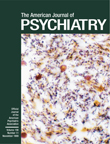Effectiveness of Olanzapine Treatment for Severe Obsessive-Compulsive Disorder
To the Editor: Although haloperidol and pimozide are commonly employed in treatment augmentation strategies for severe obsessive-compulsive disorder (OCD), the role of atypical neuroleptics is still unclear (1). Some reports suggest that risperidone and clozapine may induce OCD symptoms (2, 3); a patient with schizophrenia was written about recently whose obsessive-compulsive symptoms worsened with olanzapine treatment. However, we report on two severe cases of patients with OCD who dramatically improved after olanzapine was added to treatment with selective serotonin reuptake inhibitors for 3 months.
Mr. A, a 21-year-old man, had been suffering from OCD for 4 years, and his mother suffered from type II bipolar disorder. His main obsession was contamination, and his compulsions (washing rituals) occupied 8 hours a day, rendering him unfit for college or employment. Various treatments and augmentation strategies at appropriate doses had been ineffective. His Yale-Brown Obsessive Compulsive Scale total score at his first psychiatric interview was 40. He was taking sertraline, haloperidol, risperidone, and diazepam, but all psychiatric drugs were discontinued except sertraline (150 mg/day), and olanzapine (5 mg/day) titrated up to 10 mg/day over a week. After 15 days, Mr. A reported significantly lessened anxiety and, after 1 month, significantly lessened obsessive-compulsive symptoms. By the third month, his symptoms were occurring for only minutes each week (Yale-Brown Obsessive Compulsive Scale total score of 6). At this point, he decided to work and to attend evening school.
Ms. B, a 29-year-old woman, suffered from OCD (with postpartum onset 4 years previously) and had a father who suffered from OCD and alcohol abuse and a mother with type II bipolar disorder. She had order and symmetry obsessions and compulsions that consisted of repeated checking, counting rituals, and washing objects in her room, where she spent 7 hours a day. She became anxious when anyone entered her room and interfered with her rituals. Ms. B was unable to work; her familial and social relationships were severely impaired. Of the various treatments, only fluvoxamine (300 mg/day) led to temporary improvement. Ms. B was given an added 5 mg/day of olanzapine, titrated up to 15 mg over 2 weeks. After 20 days, the dysphoria and irritability that were associated with her compulsions had lessened notably, and over 3 months, her Yale-Brown Obsessive Compulsive Scale total score had decreased progressively from 40 to 8. Her compulsions then occupied only 10 minutes a day. She was undergoing cognitive behavioral therapy and intended to work.
These case reports suggest that olanzapine may help severe, otherwise untreatable patients with OCD and might help resolve frequent diagnostic dilemmas regarding patients with schizophrenia with obsessive-compulsive symptoms and patients with psychotic features with OCD. It is interesting that both patients’ mothers were suffering from type II bipolar disorder: this observation, supported by similar findings in other patients, suggests that having a family history of bipolar disorder might predict a good response to olanzapine. Further assessment of the potential benefits of olanzapine treatment in a defined subgroup of treatment-resistant patients with OCD is warranted.
1. Baker RW, Bermazonn PC, Wirshing DA, Chengappa KNR: Obsessions, compulsions, clozapine and risperidone. Central Nervous System Spectrums 1997; 2:6–36Google Scholar
2. Patel B, Tandon R: Development of obsessive-compulsive symptoms during clozapine treatment (letter). Am J Psychiatry 1993; 150:836Medline, Google Scholar
3. Morrison D, Clark D, Goldfarb E, McCoy L: Worsening of obsessive-compulsive symptoms following treatment with olanzapine (letter). Am J Psychiatry 1998; 155:855Medline, Google Scholar



